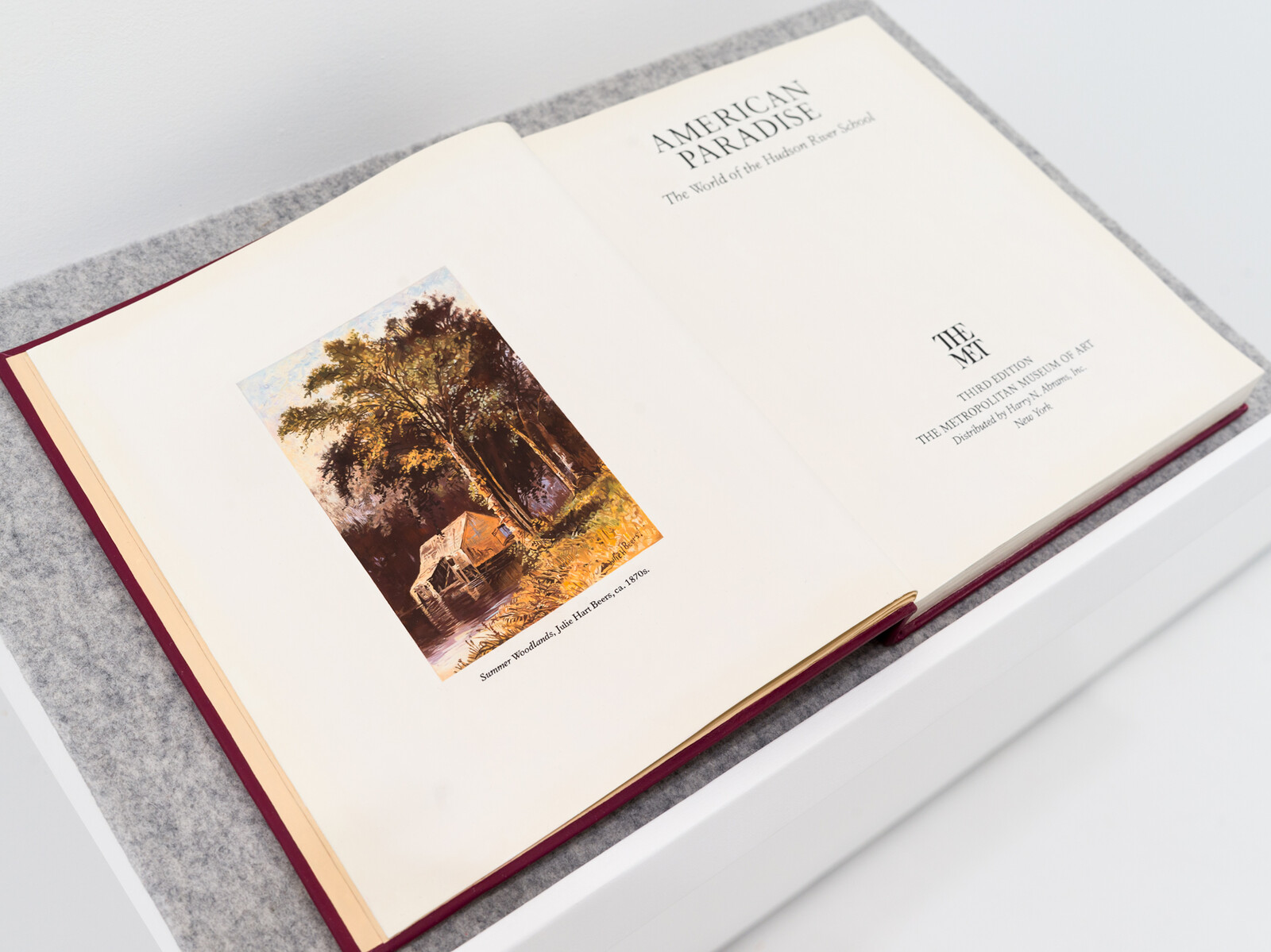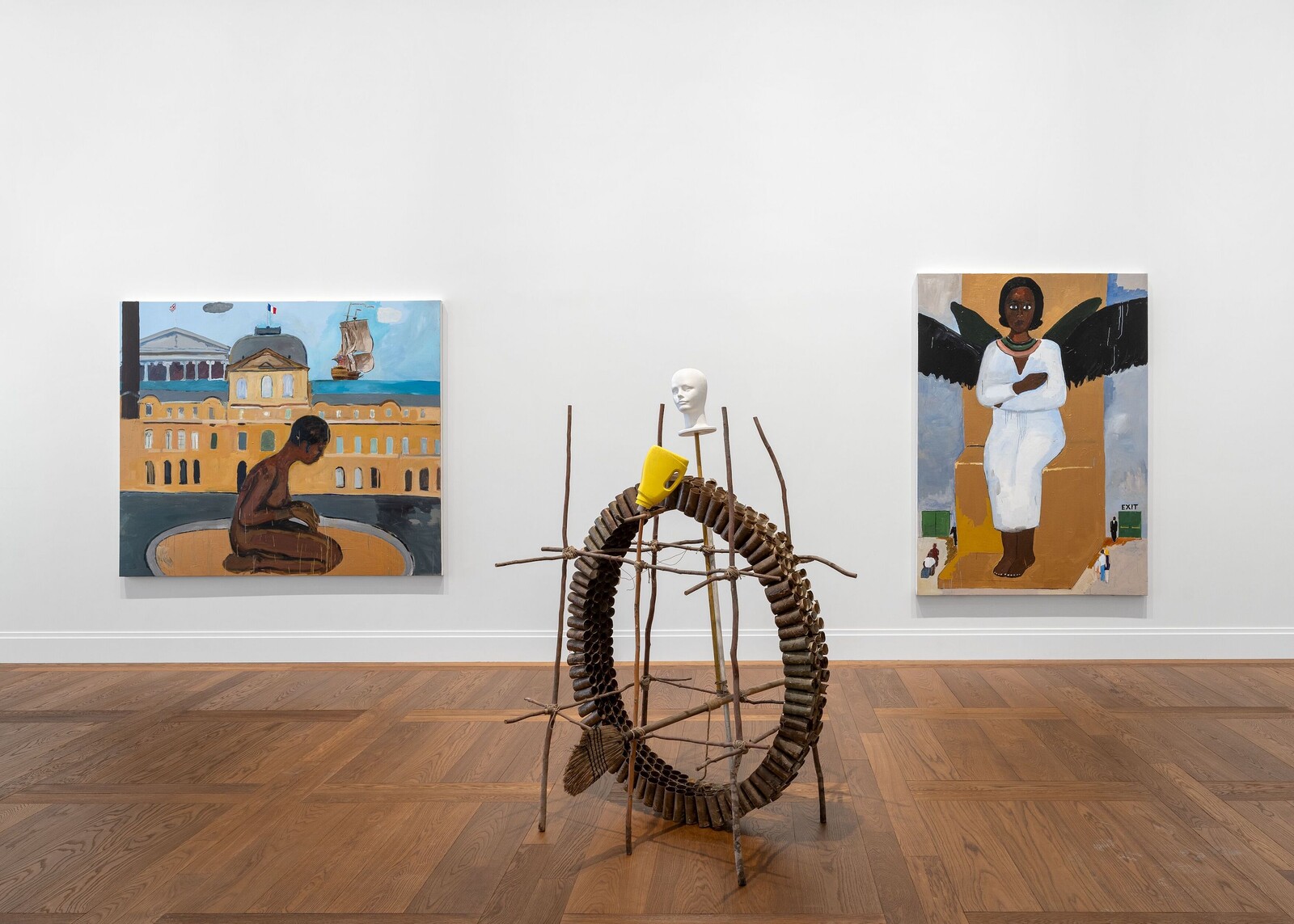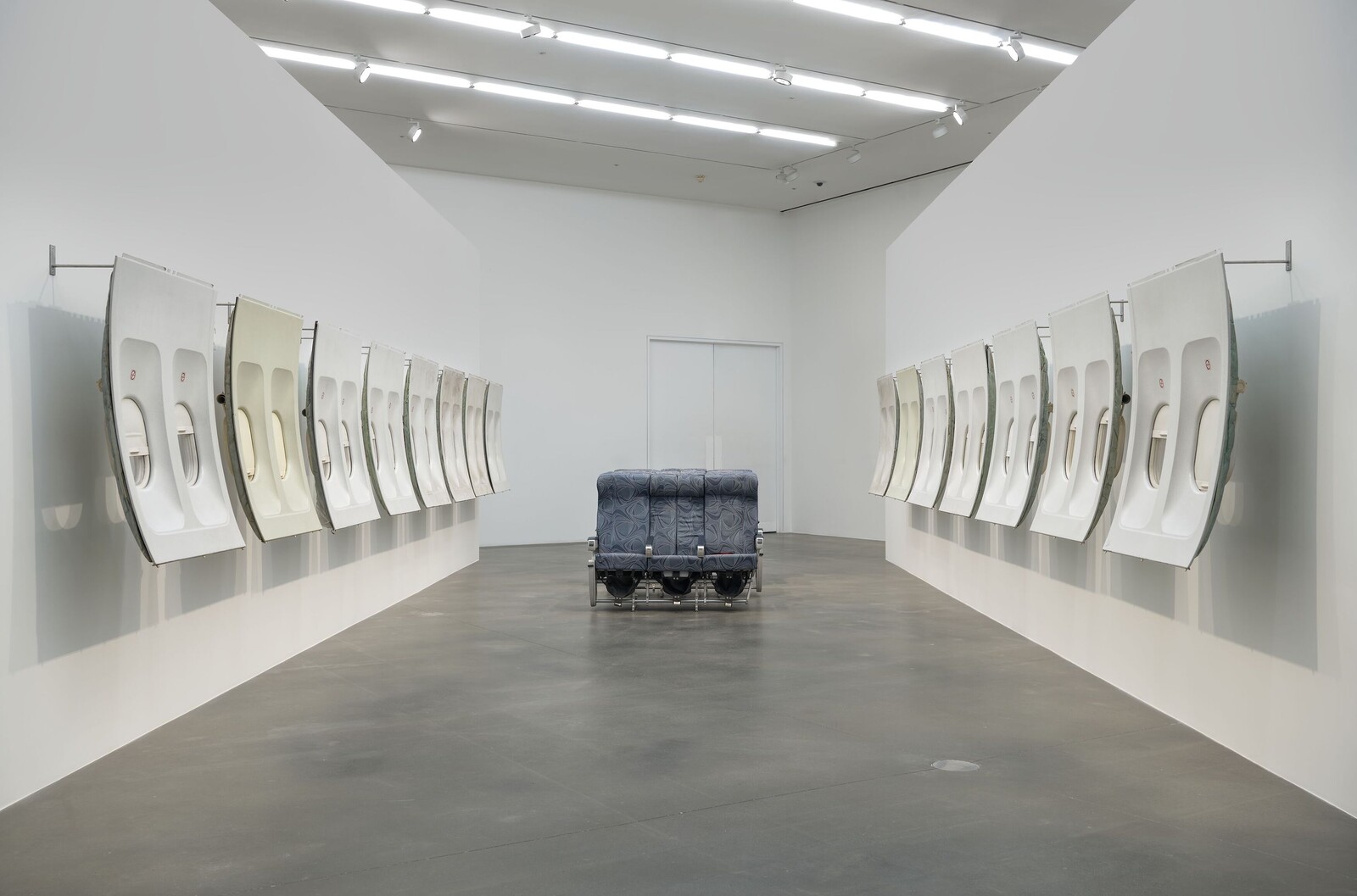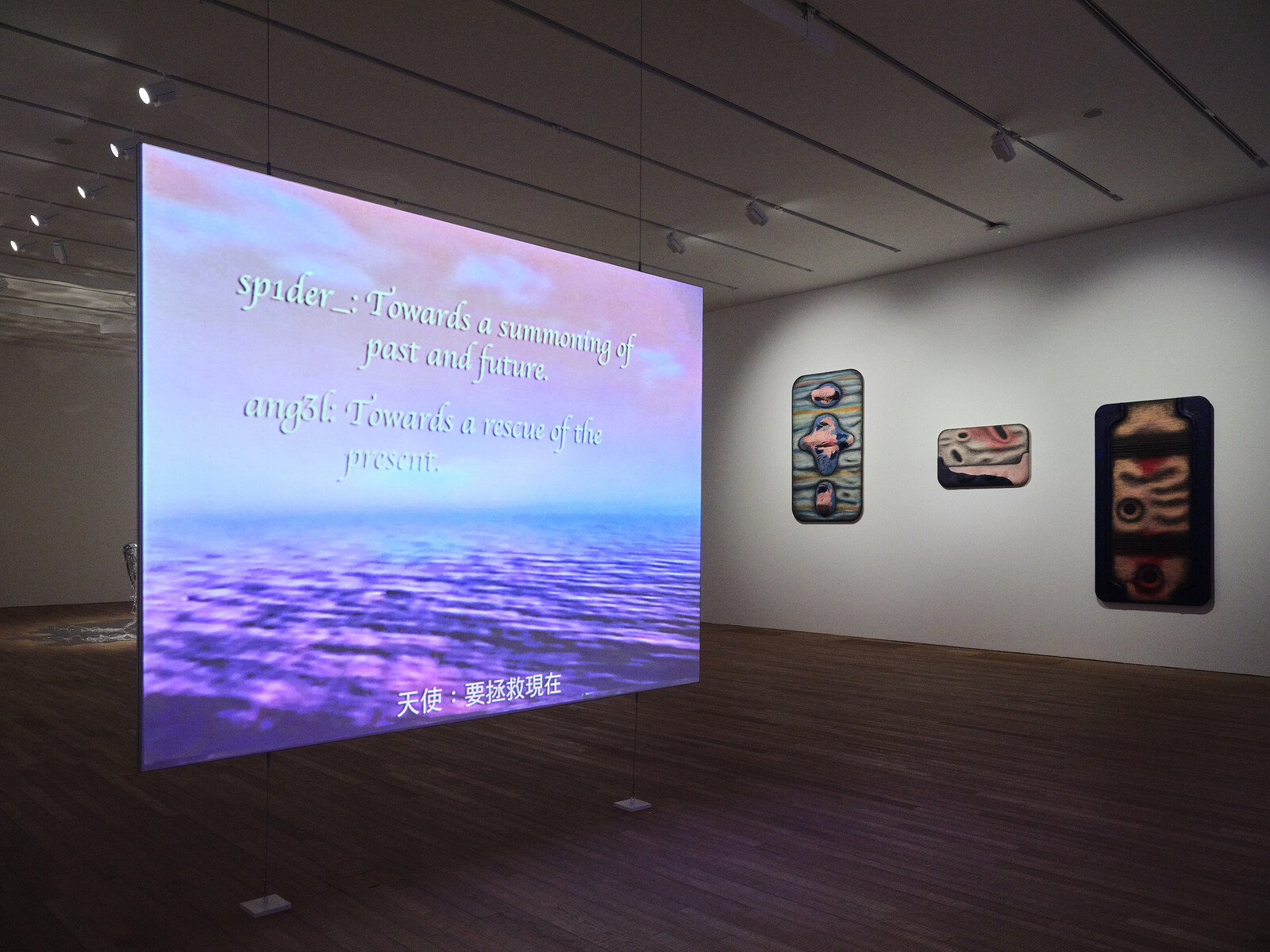Categories
Subjects
Authors
Artists
Venues
Locations
Calendar
Filter
Done
September 20, 2024 – Feature
New York City Roundup
Orit Gat

“American Paradise”: Anna Plesset took the title of her show at Jack Barrett Gallery from a 1987 exhibition at the Metropolitan Museum of Art about the nineteenth-century Hudson River School of American landscape painting, which featured twenty-five male artists and not a single woman. Plesset responds by researching the work of women artists of the time, applying an astonishingly skillful trompe l’oeil technique to the task of filling in historical gaps.
Her show opens with a sculpture mimicking the original exhibition’s catalogue, a perfect facsimile in oil on epoxy, aluminum, and steel placed on a plinth. Ostensibly the catalogue’s third edition (only one edition was published), the frontispiece is here replaced with a painting by a woman artist, Julie Hart Beers. In Value Study 2: Niagara Falls / Copied from a picture by Minot / 1818 (2021), Plesset paints an impeccable reproduction of the paper printout of an online image search for Louisa Davis Minot’s painting of the waterfalls, as if adhered to the canvas for reference using blue painter’s tape. The canvas itself shows the sketch and a beginning of a copy of Minot’s original. Plesset’s realism is not a remedy for historical injustice but a conceptual stop-and-start, a …
December 13, 2023 – Review
Henry Taylor’s “From Sugar to Shit”
Novuyo Moyo

The people in Henry Taylor’s paintings are usually surrounded by slabs of color, a graphic sensibility he shares with his high school peers and alternative comic book artists Los Bros Hernandez, whom he credits with setting the bar for his work. “I always thought, ‘Damn, they draw so much better than I.’ So I started just practicing my draftsmanship because of them. They intimidated me.” Taylor worked for ten years as a technician at Camarillo State Mental Hospital while studying at CalArts, providing assistance to some of the area’s most vulnerable people and at times featuring them in his drawings and paintings, developing the empathetic lens through which he would continue to frame his subjects.
Set in Hauser and Wirth’s Parisian multi-story outpost, and consisting of works made between 2015 and 2023 (the most recent made during a stay in Paris over the summer), “From Sugar to Shit” connects past and present, interior and exterior, public and private. Taylor’s subjects range from famous faces to personal acquaintances, but his frank, inquisitive approach sees both groups as equally worthy of commemoration. It’s not always clear whether he works from memory, archival materials, a live sitting, or a combination of these, but …
June 29, 2020 – Feature
London Roundup
Ben Eastham

Every time I approach White Cube’s gleaming south London base, I am reminded of a trope in science-fiction films: a professor of linguistics is whisked to a top-secret government facility, decontaminated, and introduced to an alien intelligence whose ominous burps she is tasked with translating. These daydreams are no doubt prompted in part by mental association with Brian O’Doherty’s Inside the White Cube (1976), which drily observes that the “ideal” contemporary art space “must be sealed off from the outside world” in order to preserve the closed system of values that operates within it. But pulling on a mask, sterilizing one’s hands, and confirming one’s identity with a security guard lends these visions a new lucidity.
Beyond the hermetic seal, Cerith Wyn Evans’s experiments in sculpture and installation are right at home within the self-contained network of relations that O’Doherty describes, with a roomful of smashed glass screens referencing the high-modernist touchstones of Duchamp’s The Bride Stripped Bare by Her Bachelors, Even (1915–23) and its documentation by Man Ray. Two potted trees rotating slowly on turntables, their branches splayed over a cruciform bamboo trellis and illuminated by a spotlight that casts their silhouettes over the far wall, suggest an …
January 15, 2020 – Feature
Hong Kong Roundup
Travis Diehl

A citywide rally on December 8, 2019, marked six months of pro-democracy protests in Hong Kong. 800,000 people attended—a tenth of the total population. When I arrived the following weekend, the streets were quiet. I wasn’t there for the protests—I was there to see art. Yet I couldn’t escape the feeling that we were, as Allan Sekula wrote of the 1999 Seattle protests, “waiting for teargas”—in the lull, anticipating the moment when revolution and counter-revolution show their true selves. Meanwhile, the Hong Kong police were thinking about art, too. On December 12, they posted a parody of Maurizo Cattelan’s Comedian sculpture (2019) to social media; in their version, instead of a banana, a teargas canister is duct-taped to the wall. This is possibly the most pitch-perfect, frank response from the government so far: lobbing riot grenades is a day job for some, but only an artwork can express the underlying depths of official apathy. The Hong Kong “banana” joined the graffiti along the roadways in Central, slogans like “thx president trump / make hk great again” and “je me révolte, donc je suis”: messages meant, on some level, for outsiders like me.
The art scene, too, seemed to be steeling …
October 21, 2014 – Review
Pierre Huyghe’s “In. Border. Deep”
Jeremy Millar

Amber is a form of slow catastrophe, a long compression. A transformation, then, of the resin which once flowed thickly down branch and trunk before these extremities were replaced by those of heat and pressure found deep within chthonic sedimentation. A “beaming sun” (elektron) caught underground, amber’s classical name was “electrum,” and it was said to have formed from the tears of Phaeton’s grieving sisters after they had themselves been transformed into poplars. Their father was the sun.
The sun, its aurorae, planets, seem to drift through a gaseous space in the film De-extinction (2014), although these supposed objects—these points of light—are little more than an absence in that which surrounds them, bubbles of air caught in amber. Caught, too, are strands of… what, exactly? Of the formerly alive, and particles of dust, too, formerly of the living. Most particular are the two insects caught at their most vital, at the point of copulation, and if reproduction might be considered merely a form of genetic persistence then this, here, is both arrested and enabled by their gem-like enveloping. Their genes persist, as they themselves do, in one form or another.
“In one form or another” might indeed be considered an emblem of …